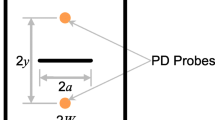Abstract
This paper describes a set of experiments conducted to demonstrate application of weight-function methods to experimental stress-intensity-factor calibrations. The weight-function method allows stress-intensity-factor and crack-surface-displacement information obtained for one loading to be generalized in a form which allows direct computation of stress-intensity factors for other load configurations applied to the crack geometry under consideration. The specific results described here demonstrate that experiments with edgecracked strips loaded in four-point bending also provide stress-intensity factors for remote lension and three-point bend-load applications.
Similar content being viewed by others
References
Bueckner, H.F., “A Novel Principle for the Computation of Stress Intensity Factors,”Zeitschrift für Angewandte Mathematik und Mechanik,50,529–546 (1970).
Rice, J.R., “Some Remarks on Elastic Crack Tip Stress Fields,”Int. J. of Solids and Struct.,8 (6),751–758 (June 1972).
Grandt, A.F., Jr., “Stress Intensity Factors for Some Through-Cracked Fastner Holes,” Int. J. of Fract.,11 (2) (April 1975).
Grandt, A.F., Jr., Two Dimensional Stress Intensity Factor Solutions for Radially Cracked Rings, AFML-TR-75-121, Air Force Material Laboratories, Wright-Patterson Air Force Base (Oct. 1975).
Petroski, H.J. and Achenbach, J.D., “Computation of the Weight Function from a Stress Intensity Factor,” Eng. Fract. Mech.,10 (2), 257–266.
Labbens, R., Pellissier-Tanon, A. and Heliot, J., “Practical Method for Calculating Stress Intensity Factors Through Weight Functions,” Mechanics of Crack Growth, ASTM STP 590, Amer. Soc. for Test. and Matls., 368–384 (1976).
Paris, P.C., McMeeking, R.M. and Tada, H., “The Weight Function Method for Determining Stress Intensity Factors,” Cracks and Fracture, ASTM STP 601, Amer. Soc. for Test. and Matls., 471–489 (1976).
Sharpe, W.N., Jr., “Interferometric Surface Strain Measurement,”Int. J. of Nondestr. Test.,3,56–76 (1971).
Macha, D.E., Sharpe, W.N., Jr. and Grandt, A.F., Jr., A Laser Interferometry Method for Experimental Stress Intensity Factor Calibration, Cracks and Fracture, ASTM STP 601, Amer. Soc. for Test. and Matls., 490–505 (1976).
Bar-Tikva, D., “An Experimental Weight Function Method for Stress Intensity Factor Calibration,”Technical Report AFWAL-TR-80-4001, Materials Laboratory, Air Force Wright Aeronautical Laboratories, Wright-Patterson Air Force Base, OH (April 1980).
Paris, P.C. and Sih, G.C., “Stress Analysis of Cracks,” Fracture Toughness Testing and Its Applications, ASTM STP 381, Amer. Soc. for Test. and Matls., 30–81 (1965).
Sharpe, W.N., Jr. and Grandt, A.F., Jr., A Preliminary Study of Fatigue Crack Retardation Using Laser Interferometry to Measure Crack Surface Displacement, Mechanics of Crack Growth, ASTM STP 590, Amer. Soc. for Test. and Matls., 302–320 (1976).
Sharpe, W.N., Jr., Corbly, D.M. and Grandt, A.F., Jr., “Effects of Rest Time on Fatigue Crack Retardation and Observations of Crack Closure,” Fatigue Crack Growth Under Spectrum Loads, ASTM STP 595, Amer. Soc. for Test. and Matls., 61–77 (1976).
Macha, D.E., Corbly, D.M. andJones, J.W., “On the Variation of Fatigue-crack-opening Load With Measurement Location,”Experimental Mechanics,19 (6),207–213 (June 1979).
Tada, H., Paris, P.C. and Irwin, G.R., The Stress Analysis of Cracks Handbook, DEL Research Corporation (1973).
Orange, T.W., “Crack Shapes and Stress Intensity Factors for Edge-Cracked Specimens,” Stress Analysis and Growth of Cracks, Proceedings of the 1971 National Symposium on Fracture Mechanics, Part I, ASTM STP 513, Amer. Soc. for Test. and Matls., 71–78 (1972).
Timoshenko, S.P. andGoodier, J.N., Theory of Elasticity, McGraw-Hill, New York (1969).
Brown, W.F., Jr. and Srawley, J.E., Plane Strain Crack Toughness Testing of High Strength Metallic Materials, ASTM STP 410, Amer. Soc. for Test. and Matls., 13 (1967).
Author information
Authors and Affiliations
Rights and permissions
About this article
Cite this article
Bar-Tikva, D., Grandt, A.F. & Palazotto, A.N. An experimental weight function for stress-intensity-factor calibrations. Experimental Mechanics 21, 371–378 (1981). https://doi.org/10.1007/BF02324798
Received:
Accepted:
Issue Date:
DOI: https://doi.org/10.1007/BF02324798




